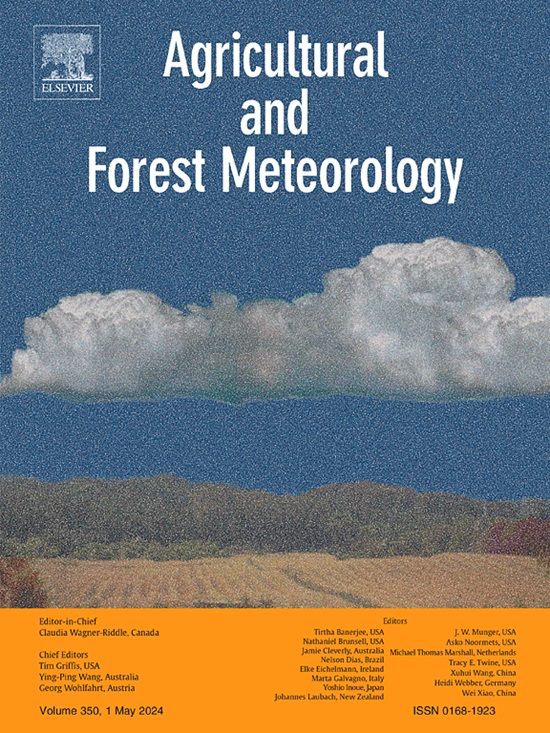黄土高原植被绿化的区域差异及气候变化对总初级生产力和蒸散量的影响
IF 5.7
1区 农林科学
Q1 AGRONOMY
引用次数: 0
摘要
黄土高原对中国的粮食和能源生产至关重要。了解该地区总初级生产力(GPP)和蒸散发(ET)的时空变化特征及其驱动因素,对于优化生态恢复策略和有效管理水资源具有重要意义。然而,土地利用转型和生态恢复政策驱动的土地利用类型和通量变化对各区域的影响尚不清楚。利用基于遥感植被指数和多期土地利用数据的模型,估算了1982 - 2017年GPP和ET的空间分布和变化趋势。因子模拟量化了气候因子和植被变化如何直接影响GPP和ET,并评估了土地利用和通量变化的贡献。结果表明:青藏高原年平均GPP和ET分别为430.5±58.7 g C - m-2和359.2±29.4 mm -1,其中土壤蒸发占ET的最大比例(42.7%),特别是沙地区(I)(58.9%)。与此同时,GPP和ET均以每年5.3 g C m-2和2.3 mm的速率显著增加。蒸散发增加主要由植被蒸腾驱动,特别是在黄土丘陵沟壑区(II)和河谷平原区(III),土壤蒸发量略有减少。植被绿化是影响GPP和ET变化的主要因素,特别是在2000年以后。包括降水和温度在内的气候因素也有助于这些增加,但它们的影响相对较小。进一步分析表明,草地和农田的通量变化是黄土高原GPP和ET增加的主要驱动因素,其中I区和II区对GPP和ET增加的贡献最大,特别是近10年来。该研究为优化干旱半干旱区生态恢复策略和平衡碳水动态提供了有价值的见解。本文章由计算机程序翻译,如有差异,请以英文原文为准。
Regional variations in vegetation greening and climate change impacts on gross primary productivity and evapotranspiration in the Loess Plateau
The Loess Plateau is vital to China's grain and energy production. Understanding the spatio-temporal variations and driving factors of gross primary productivity (GPP) and evapotranspiration (ET) in this area is crucial for optimizing ecological restoration strategies and effectively managing water resources. However, the impacts of land use types and flux changes driven by land use transitions and ecological restoration policies across regions remain unclear. Using a model based on remotely sensed vegetation indices and multi-period land use data, we estimate the spatial distribution and trends of GPP and ET from 1982 to 2017. Factorial simulations quantified how climatic factors and vegetation changes directly affected GPP and ET, and assessed contributions from land use and flux changes. The results indicate that the average annual GPP and ET for the entire plateau are 430.5 ± 58.7 g C m-2 yr-1 and 359.2 ± 29.4 mm yr-1, respectively, with soil evaporation accounting for the largest proportion of ET (42.7 %), particularly in Sandy land region (I) (58.9 %). Meanwhile, both GPP and ET have significantly increased at rates of 5.3 g C m-2 and 2.3 mm annually. The increase in ET is mainly driven by vegetation transpiration, especially in Loess hilly and gully region (II) and River valley plain region (III), while soil evaporation has slightly decreased. Vegetation greening is the dominant factor influencing GPP and ET changes, particularly after 2000. Climate factors, including precipitation and temperature, also contribute to these increases, but their influence is comparatively smaller. Further analysis reveals that flux changes in grasslands and croplands are dominant drivers of increased total GPP and ET across the Loess Plateau, with regions I and II contributing the most to these increases, particularly in the recent decade. This research provides valuable insights into optimizing ecological restoration strategies and balancing carbon-water dynamics in arid and semi-arid regions.
求助全文
通过发布文献求助,成功后即可免费获取论文全文。
去求助
来源期刊
CiteScore
10.30
自引率
9.70%
发文量
415
审稿时长
69 days
期刊介绍:
Agricultural and Forest Meteorology is an international journal for the publication of original articles and reviews on the inter-relationship between meteorology, agriculture, forestry, and natural ecosystems. Emphasis is on basic and applied scientific research relevant to practical problems in the field of plant and soil sciences, ecology and biogeochemistry as affected by weather as well as climate variability and change. Theoretical models should be tested against experimental data. Articles must appeal to an international audience. Special issues devoted to single topics are also published.
Typical topics include canopy micrometeorology (e.g. canopy radiation transfer, turbulence near the ground, evapotranspiration, energy balance, fluxes of trace gases), micrometeorological instrumentation (e.g., sensors for trace gases, flux measurement instruments, radiation measurement techniques), aerobiology (e.g. the dispersion of pollen, spores, insects and pesticides), biometeorology (e.g. the effect of weather and climate on plant distribution, crop yield, water-use efficiency, and plant phenology), forest-fire/weather interactions, and feedbacks from vegetation to weather and the climate system.

 求助内容:
求助内容: 应助结果提醒方式:
应助结果提醒方式:


